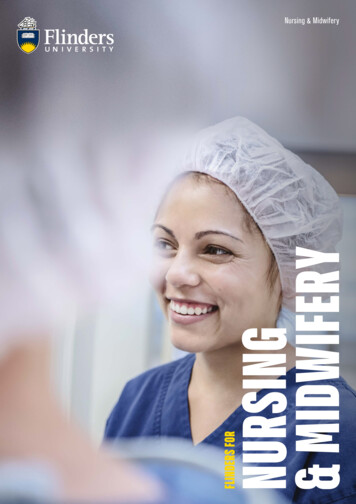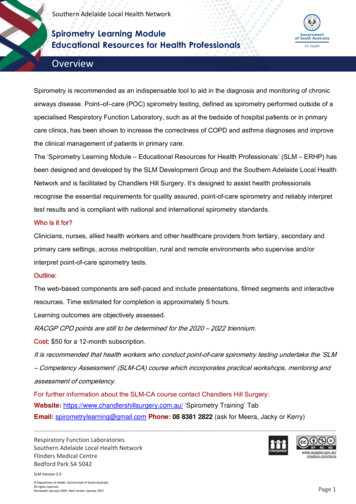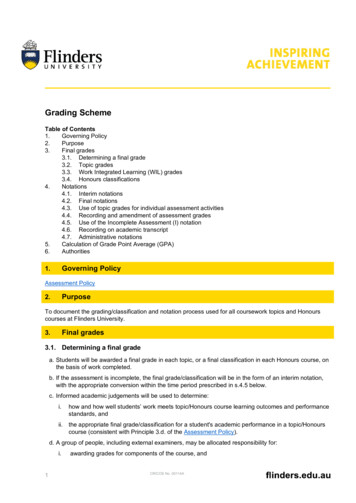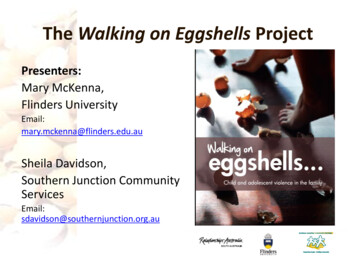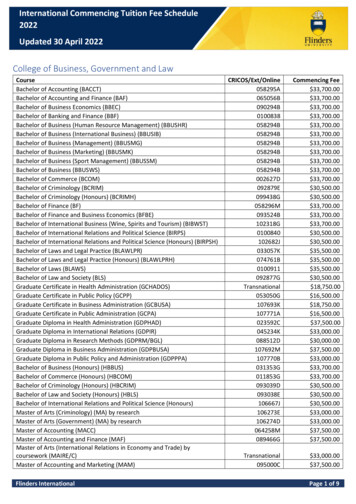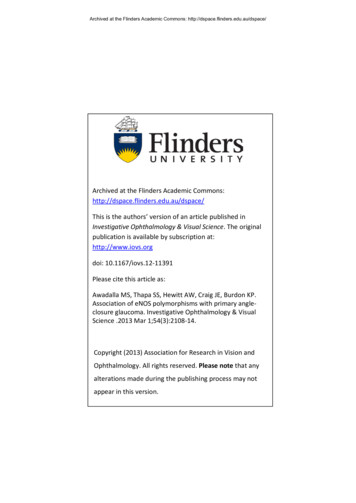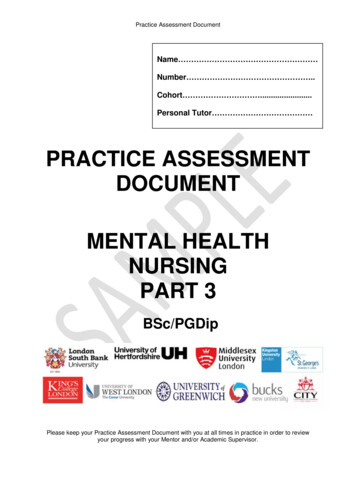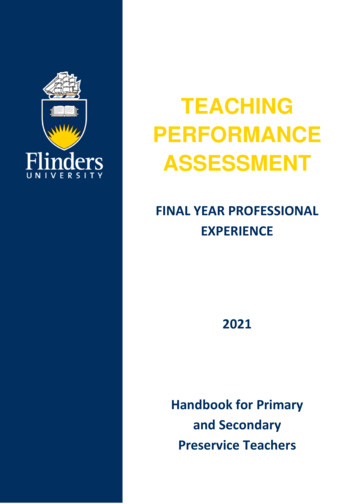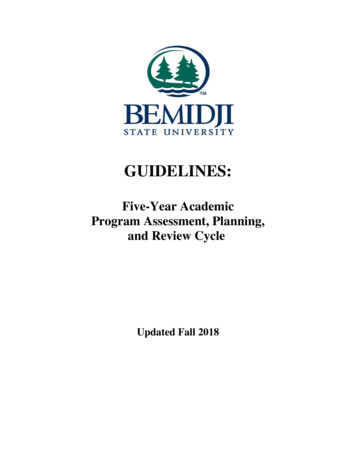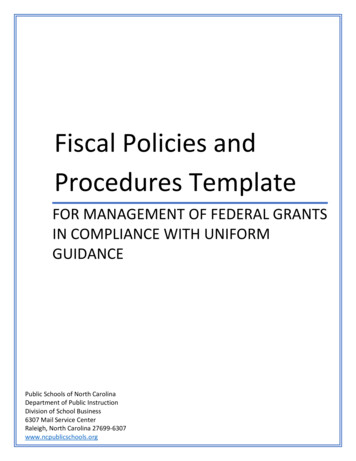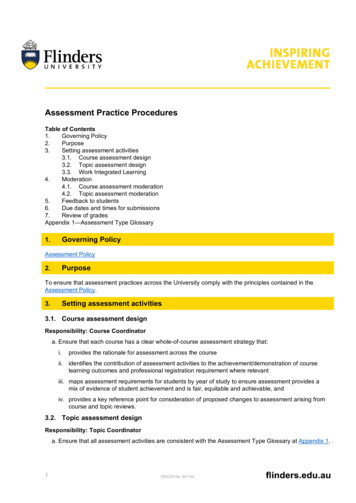
Transcription
Assessment Practice ProceduresTable of ContentsGoverning Policy1.2.Purpose3.Setting assessment activities3.1. Course assessment design3.2. Topic assessment design3.3. Work Integrated Learning4.Moderation4.1. Course assessment moderation4.2. Topic assessment moderation5.Feedback to students6.Due dates and times for submissions7.Review of gradesAppendix 1—Assessment Type GlossaryGoverning Policy1.Assessment PolicyPurpose2.To ensure that assessment practices across the University comply with the principles contained in theAssessment Policy.Setting assessment activities3.3.1. Course assessment designResponsibility: Course Coordinatora. Ensure that each course has a clear whole-of-course assessment strategy that:i.provides the rationale for assessment across the courseii. identifies the contribution of assessment activities to the achievement/demonstration of courselearning outcomes and professional registration requirement where relevantiii. maps assessment requirements for students by year of study to ensure assessment provides amix of evidence of student achievement and is fair, equitable and achievable, andiv. provides a key reference point for consideration of proposed changes to assessment arising fromcourse and topic reviews.3.2. Topic assessment designResponsibility: Topic Coordinatora. Ensure that all assessment activities are consistent with the Assessment Type Glossary at Appendix 1.1CRICOS No. 00114A
b. Ensure that each specific assessment activity is supported by a clear rationale for how the activityprovides the opportunity for students to demonstrate learning related to topic and course learningoutcomes.c. Ensure that examinations, defined as assessment activities that are invigilated, and generallycentrally administered, are included in topic assessment only where they are:i.demonstrated to be the most appropriate method for assessing student learning, orii. required for professional registration or accreditation.d. Ensure that attendance at specified learning events is not included as a component of the topic’s finalgrade, unless it can be explicitly and directly linked to the demonstration of achievement of:i.learning outcomesii. safe practiceiii. professional competencies, oriv. registration/accreditation requirements.e. If participation is to be a requirement for completion of a topic, ensure that there is explicit descriptionof:i.the link between participation and learning outcomes, andii. the criteria for acceptable participation.f. Ensure, as far as possible, that the combination of assessment activities:i.replicates/represents authentic practice in the disciplines/professions to which the topic relates,andii. provides sufficient data points to enable a student to demonstrate achievement of each learningoutcome and to avoid/reduce the possibility of false positive (Pass) or negative (Fail) outcomesfrom a single assessment activity.g. Ensure that:i.the number of assessment activities is kept to a minimum, appropriate to the year and AustralianQualifications Framework (AQF) level, and commensurate with the point value of the topic, andii. any larger assessment activity that makes up a major percentage of the final topic grade hasbeen clearly scaffolded with staged opportunities for the student to review learning progress.For example, a final topic grade may be determined on the basis of a single/final assessmentartefact that demonstrates the achievement of all learning outcomes e.g., placement report, thesis,creative work, performance.h. Where learning outcomes can be demonstrated through multiple, alternative assessment activities,where possible provide students with options in the types of assessment to be undertaken (subject tosafety and professional registration/accreditation requirements).i. Ensure that the requirements for successful completion – criteria and standards – for eachassessment activity are provided to, and discussed and clarified with, students before the time thatthey are expected to begin the activity; and ensure that (where appropriate) students are provided witha grading rubric for each assessment activity.2CRICOS No. 00114A
j. Ensure that any ‘hurdle requirements’, defined as assessment activities or components which mustbe passed in order to pass the topic, are:i.justified by clear rationale based on safe practice or professional competencies orregistration/accreditation requirements, andii. clearly communicated to students.Note: where a learning outcome can only be demonstrated by one assessment activity, thatassessment activity is a hurdle requirement. This should be the case only by exception and,wherever possible, learning outcomes should be able to be demonstrated by more than oneassessment activity.3.3. Work Integrated LearningWork Integrated Learning (WIL) is a particular type of learning offered in accordance with the WIL Policyand Procedures. Assessment of WIL is aligned with discipline and professional requirements but must stillapply the principles stated in the Assessment Policy, and take into account transparency, equity and load.Moderation4.4.1. Course assessment moderationResponsibility: Course Coordinator/Teaching Program Directora. Where programmatic assessment is a component of a course, ensure that:i.the relationship between assessment results and progression decisions is explicit andcommunicated to staff, andii. progression decision processes are robust, consistent and considered, and informed by sufficientdata.Responsibility: College Dean (Education)b. Formally review grade distribution and approve for release topic final grades and final notations (asprovided in the Grading Scheme).c. Identify topics for external calibration in accordance with the Academic Calibration Procedures.4.2. Topic assessment moderationModeration is to occur at three stages in the assessment cycle: at the time of topic assessment design,during teaching delivery and when submitting topic final grades.Responsibility: Topic Coordinatora. At the time of topic assessment design, ensure assessment designs and information, includinggrading rubrics, are verified through discussion with at least one colleague experienced in assessmentb. Where more than one staff member is involved in assessment and grading, meet with the teachingteam before the commencement of the topic to discuss assessment requirements and markingexpectations, to ensure:i.alignment in interpretation of the assessment specifications, rubrics and marking guidesii. consistency in information provided to students and in grading practice, andiii.consistency in feedback practices in the topic.c. During teaching delivery, ensure mechanisms are in place to validate assessment judgements ofmarkers. The most commonly used mechanisms are:i.second, double or collaborative markingii. random review of marking and grades, and/oriii. consensus discussions.3CRICOS No. 00114A
d. When submitting topic final grades:i.certify that moderation has occurred, the spread of grades reflects student achievement of learningoutcomes, and anomalies have been identified and resolved, andii. provide reasons for incomplete and fail grades.Feedback to students5.Responsibility: Topic Coordinatora. Approve the grade for summative assessment activities, including where the assessment judgement isinformed by other academic staff and/or external supervisors e.g. Work Integrated Learningsupervisors.b. Ensure that:i.students are provided with usable feedback to support their progress toward achievement of thelearning outcomes for the topic and selected courseii. feedback is clear, explicit, actionable and focused on enabling students to improve their learningiii. where an assessment activity is submitted and returned to the student electronically, theassociated feedback is also provided electronically, andiv. a completed rubric is provided after marking of tests and exams as the minimum requirement forfeedback.c. The University’s expectation is that, where practical, feedback on graded assessment activities isreturned to students two weeks after the due date for submission or the actual submission date,whichever is later. The timing for the return of feedback must be communicated to the students inadvance.Due dates and times for submissions6.Responsibility: Topic Coordinatora. Ensure that each assessment activity has a specified due date and time, taking into account:i.where possible, the due dates for other assessments in the topic and course,ii. the expected effort to complete the assessment and other assessments in the topic, andiii. the requirements in b. and c. below.b. Due dates and times for submission of assessment activities must be set between 9am and 4pmAustralian Central Standard Time (ACST) Monday to Thursday, unless there are good reasons foranother time to be set.c. In a topic that includes an examination, any assessment activity that is not the examination must havea due date no later than seven calendar days before the beginning of the relevant examination period,unless there is a good reason for a later due date to be set that is approved by the College Dean(Education).d. Ensure that the due date and time of each assessment activity, and the consequences of latesubmission (see e. and f. below), are communicated to students in the topic assessment information,e.g., handbook.Responsibility: College Dean (Education)e. For each assessment activity, determine the consequences of late submission (i.e., a late submissionnot approved under the Assessment Variation Procedures) in accordance with f. below, ensuring thatthere is consistency of consequences within each course, except where demonstrably justified byparticular reference to one or more topic learning outcomes.4CRICOS No. 00114A
f. Where there is a percentage deduction for late submission, the deduction must be set at not less than1% and not more than 5% of the total marks possible for the assessment activity for every 24-hourperiod (or part thereof) after the submission due time.Review of grades7.a. Consistent with the requirements of the Student Review and Appeal Policy, a student who isdissatisfied with a grade for an assessment activity or a final topic grade should discuss the matter withthe Topic Coordinator in the first instance. The Topic Coordinator will inform the student of the reasonsfor the grade awarded.b. A student may request a review of a grade for an assessment activity or a final topic grade inaccordance with the Student Review and Appeal Policy and procedures on the grounds that theAssessment Policy, supporting procedures, topic information or grading rubrics have not been adheredto or have been incorrectly applied.c. If the request for a review is substantiated, the reviewer may:i.arrange for an independent grading of the assessment activity(ies)ii. offer an alternative or supplementary assessment, oriii. take any other reasonable action appropriate to the circumstances.d. If a grade is amended as a result of a review it will be the grade awarded for the assessment activity ortopic, irrespective of whether it is higher or lower than the original grade.e. A student who is dissatisfied with the outcome of the review may appeal to the Student AppealsCommittee, if specified grounds are met, in accordance with the Student Review and Appeal Policyand procedures.Approval AuthorityDeputy Vice-Chancellor (Students)Responsible OfficerPro Vice-Chancellor (Learning and Teaching Innovation)Approval Date3 December 2020Effective Date1 January 2022Review Date*January 2025Last amendedDeputy Vice-Chancellor (Students), 14 July 2021CM file numberCF20/740* Unless otherwise indicated, this procedure will still apply beyond the review date.Printed versions of this document are not controlled. Please refer to the Flinders Policy Library for the latest version.5CRICOS No. 00114A
Appendix 1—Assessment Type GlossaryAssessment typeIncludes (but is not limited to):DescriptionAbstractAbstract of a research paper/articlewithin a specified word limitStudents demonstrate the capacity tosynthesise and condense ideas.AnnotatedbibliographyAnnotated lists of texts, primary sources Students demonstrate capacity to:and/or internet sites produce a list of relevant texts on aspecified or agreed topics annotate these with a commentary,which could include an evaluation ofwhat they have read use a particular referencingconvention.Artefact creationSculptures, drawings, performing in orproducing an original play or film,literary texts, learning materials, lessonplans, computer programs, machines,physical modelsStudents produce an original creativework, irrespective of medium (includingprocess, stages and/or final product).Article fordifferentaudiencesMedia profiles, minutes, patchworktexts, blogs, wikis, professional plans,summaries, review or critical analysis ofresource(s), web page creation,discussion forum, participative onlinediscussion, literature reviews, accountor oral presentation, research proposal,YarningStudents demonstrate capacity todevelop these concise formats, whichcould include an evaluative element toreflect depth of reading and level ofunderstanding. Could also includeengagement in a conservation processwhere they collect data by engaging withIndigenous Knowledge in groups throughdesigning and undertaking a Yarningsession.Case studyProblem sheet, critical quality audit ofpractice or organisation, report, casenotesStudents work through a case study todemonstrate their capacity to identify theproblem(s), engage in reflective practiceand/or offer potential solutions.CollaborativeactivitiesPresentations, artefactsStudents work as a group and contributeto an end product as part of a group andare assessed on their contribution, thiscould include engaging in Team BasedLearning, problem-based learning orproject work.Concept mapConcept map, conceptual diagramStudents develop a diagrammaticrepresentation depicting suggestedrelationships between concepts or ideas.DemonstrationPresentations, practical, laboratories,project management, ObjectiveStructured Clinical Examinations(OSCEs), competence checklistsStudents engage in exhibiting theirrelevant skills.Dissertation /thesisLarge piece of work (usually written)Students demonstrate capacity to:6 CRICOS No. 00114Aadhere to an accepted format
Assessment typeEssayIncludes (but is not limited to):Reflective essay, descriptive essay,narrative essay, argumentative essay,critical essay, persuasive essayDescription use a wide range of practical,analytical and interpretative skills relate a broad application ofknowledge, understanding and skillsto a range of situations.Written work following a specific format(introduction, body, conclusion) wherestudents demonstrate capacity to: write on specified or agreed topicswithin given parameters e.g. wordcount use different literature sources convey and/or critically assess ideason a given topic reflect depth of understanding.ExaminationOpen or closed book, oral/viva voce,written, OSCEsStudents complete set practicaltasks/questions in pre-determined, timerestricted, invigilated conditions coveringprofessional, practice or performancerelated proficiencies.ExhibitionSculptures, drawings, posters, learningmaterialsStudents curate a collection of works.InterviewFocused questioning of fellow students,expertsStudents demonstrate: oral and/or written skills capacity to synthesise and analyseresponses appropriate questioning ofparticipant(s).Laboratory bookLaboratory or workbooksStudents document their work in alaboratory setting.Oral presentationDebates, critiques, advocacy, casestudies, role plays, videoStudents engage in a form of oraldiscourse on a specified or agreed topic.ParticipationIn class discussions, online discussions, Students engage in set activitiescontributing to one off small groupspecifically related to ability to meet topicactivitieslearning outcomes.Peer assessment / Rubric responses, in class discussionsreview(online or in person), marking sheetsStudents demonstrate their capacity toassess their peers’ skills or review thework or contributions of (near-) peers.This can occur as part of a community ofpractice, in groups, or individually.PerformanceConcert, play, dance, filmStudents’ capacity to perform in variouscontexts are assessed.PlacementperformanceassessmentPlacement provider reportsStudents demonstrate skills /competencies while engaged in activities7CRICOS No. 00114A
Assessment typeIncludes (but is not limited to):Descriptionintegrating theory with the practice ofwork.Portfolio /e-portfolioReflective journal / diary, selfassessment, learning log, self-reflectivestatement, philosophy statementStudents provide evidence for theirachievement of learning outcomes, thesecommonly incorporate a reflectivecommentary.ProfessionalapplicationGrant applications, ethics applications,job applications, pitches, strategic planStudents demonstrate their capacity todevelop appropriate resources linked totheir specific professional context orpotential employment.Quiz / TestMultiple choice questions, questionbanks, short or long answer responses,in-class testStudents respond to questions assessingknowledge.ReportFull reports, selective / samplingreports, Field report / work, practicalreports, research report, communityprofileStudents prepare a written documentfollowing a specified format.StudentnegotiatedassessmentFormat, length, grade percentage, topicarea, choice from a list or free reignStudents negotiate their own assessmenttask.WorkbookSpecific formats can be linked tolanguage studies or other areasStudents respond to questions within aworkbook.8CRICOS No. 00114A
Course assessment design 3.2. Topic assessment design 3.3. Work Integrated Learning 4. Moderation 4.1. Course assessment moderation . alignment in interpretation of the assessment specifications, rubrics and marking guides ii. consistency in information provided to students and in grading practice, and . web page creation, .
